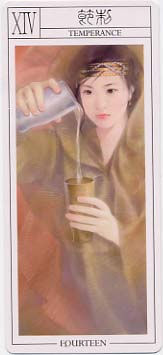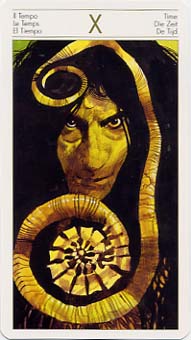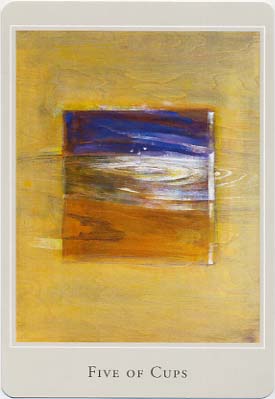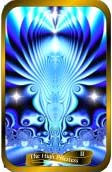Beyond Symbols: Different Ways of "Seeing" the Tarot
Posted by Jeannette Roth on Jul 9th 2018
Preface: This is another essay that was originally published in the eZine Timeless Spirit. I wrote it in 2005, in response to a number of reviews, articles, and posts I had read, criticizing certain types of tarots for reasons I felt arose from taking a very narrow view of the subject matter. I think in the intervening decade-plus, people's perspective on what constitutes a "useful" or "valid" approach to tarot has broadened somewhat. But, as always, I also believe that a little reexamination now-and-again doesn't hurt. Plus, this was the first time I publicly introduced the term "character-driven tarot". Yeah, I'm totally taking credit for that.
A question, submitted for your consideration, gentle reader: Do the blind "see"?
The answer, obvious by definition: no, of course not. To be blind is to be unable to receive and process optical data, so that sight is not possible.
Except…
In English, the word "see" has multiple meanings – among them, "to understand." Despite their visual impairment, is there anyone who would argue that the blind do not have a comprehensive and accurate understanding of the world around them? To be sure, that understanding is gained in a different manner than the manner in which it is acquired by sighted people. Yet despite their reliance on differing sensory modes, a blind person and a sighted person can agree on many, perhaps most, aspects regarding the nature of "mundane reality."
For example, if you ask a person who has been blind from birth to describe a cat, the result will be a list of qualities that agrees with the perceptions of a non-visually impaired person: fur, four legs, two ears, a tail, makes a "purring" sound, chases mice, etc.…
Without a doubt, the blind "see" – that is to say, they have a functional understanding of the world. Exactly how they gained that understanding is irrelevant, from the standpoint of their day-to-day interactions with others and with their environment.
Tarot, Meaning, and the "Inner World"
The purpose of the preceding exercise is to establish the metaphorical groundwork for a discussion of a group that I'll refer to as the "symbologically blind." This is not to suggest that there exists a class of people who are incapable of seeing symbols, in the visual sense. Clearly, anyone with normal eyesight can visually perceive a symbol within an illustration. But with tarot – as always, the true topic of our discussion – we also explore the cards with our "inner eyes;" that is, we contemplate the deeper meanings of the images before us, in order to gain a functional understanding of the inner, or psychological, world. Even a reader capable of performing fluidly intuitive readings will tend to assign some manner of stable significance to the cards when working with the cards outside of a reading situation. If we are using the cards for self-improvement and personal spiritual guidance, it is necessary to establish some consistency in their meanings in order to have any hope of learning what they have to teach us.
The question is: how do individuals identify the elements within the cards that are intended to bring about this understanding of their meanings? As in the physical world, it may be a mistake to assume that we all use the same "sensory modes" for gathering information on the inner planes…
Symbol and "Sensory Modes" on the Inner Planes
For a tarot that aspires to be more than a mere novelty item, we assume that the deck's creator(s) will have made an attempt to imbue its imagery with some significance. Whether or not the results are successful can only be judged on a case-by-case basis, and is not the point of this essay. What is important, for purposes of the present discussion, is the nature of the components used to construct that significance.
Traditionally, the establishment of significance is achieved through the inclusion of symbolic elements – specific icons within the illustration intended to represent an idea or a constellation of ideas. These elements can be as simple as a single archetypal, even stereotypical, image – a roulette wheel for the "Wheel of Fortune" card, for example – or as complex as Hermetic minutiae embedded into the image in layers and cross-referenced throughout the deck. When well selected and well executed, these symbols provide the intellect with a metaphorical foundation for more tenuous metaphysical concepts – concepts that are not always easily or concisely expressible within the limitations of normal human communication.
But intellect is not the only mode by which we gather and process information on the inner planes. At the very least, emotion and intuition also play their own roles in shaping our psychological reality – a fact exploited by certain groups, such as advertisers and politicians, who often find it more effective to appeal to their audiences on an irrational (non-intellectual) level. In light of this fact, it may be an error to assume that the first steps on path to enlightenment, as it is presented to us through the medium of tarot, should invariably pass from the cards to the spirit via the intellect. Nonetheless, while this particular part of the process is generally not overtly stated in the documentation for any particular tarot deck, it is, for most of us, the functional reality. It is the intellect that grasps the surface metaphor of a symbol, converting it to its deeper, "non-rational" significance (through contemplation, meditation, or other means), which can then be further processed and utilized by other levels of the psyche.
The Limitations of Symbols
Let us now return to our earlier question: that is, how do individuals identify the elements within the cards that are intended to bring about an understanding of their meanings? If results followed intent, then students of the cards would recognize the symbolic elements placed within the cards' illustrations, intellectually decipher their metaphorical intent, and from there, extrapolate their actual significance for application on the inner planes. However, there are two potential problems with this process:
1) The student may lack the proper background knowledge needed to identify the metaphorical intent of the symbol. It may be all well-and-good, for example, for a deck creator to use the Greek alpha and omega symbols on a card to represent "the beginning and the end." But if the student is unfamiliar with these Greek letters, let alone the occult ideas associated with them, then it becomes extremely difficult for the student to move to the next stage of understanding.
Fortunately, there is a relatively simple solution to the preceding dilemma. As long as adequate documentation exists explaining the proper associations for the symbolic elements, then students (assuming they have access to the documentation) should be able to use it to correct any gaps in their knowledge that might impede their studies. Thus, we do not need to concern ourselves with this potential difficulty at the present time.
2) The student may, by necessity, be more reliant on other psychological modes for the gathering and processing of "inner plane" information. Just as the visually impaired must rely on their other four senses in order to make sense of the world around them, so it may be possible that the unique psychological makeup of individuals predisposes them to rely more heavily on particular mental functions to make sense of the world inside them. If a particular individual is – to use the term I introduced earlier – "symbologically blind," then traditional approaches to tarot's imagery may not prove to be an effective means for stimulating that individual's spiritual growth. This is the potential obstacle of interest to us here, as the solution is not as simple as reading an appropriate book.
Is It Possible to be Blind to Symbols?
What exactly do I mean when I assert that a person could be "symbologically blind?" In brief, I am referring to the idea that for certain people, the path from card image to deeper psychological understanding may not naturally come by way of intellect and metaphor. This is not to say that such people are intellectually inferior in some way. Rather, I am simply suggesting that such individuals, for whatever reason, tend to rely more heavily on other psychological constructs when undertaking metaphysical studies. For these people, understanding the intended meaning of a symbol may still not result in an effective transition from metaphor to insight.
If this is the case, then what is the earnest seeker who may be symbologically blind to do? It may be tempting to suggest that for such a person, tarot is not the answer – that perhaps another approach that is less reliant on rational constructs from the outset (such as some of the better-known Eastern paths) would be more appropriate. And certainly there is nothing wrong with taking a different approach to spiritual studies, so long as the selected method has shown to provide effective results for the dedicated student.
However, as tarot is a discipline whose lessons remain largely imparted through the medium of illustration, we need not necessarily dismiss it as unsuitable for those who cannot easily connect with its "traditional" expression. For not all illustrations are composed of symbols, and not all art is designed to appeal to the intellect. Would it not be possible, then, to remove the concrete symbols from a tarot illustration, and replace them with some other form of visual components of equal potential, in the same way that we remove ink from a page and replace it with raised dots in order to allow the visually impaired to read? It seems like an innocent enough suggestion in theory, but in practice, the idea seems to occasionally encounter some resistance.
Symbol Substitutes
Take any deck which has whittled down its concrete images to their simplest expression – two people kissing for the "Lovers" card, for example – and you're likely to find more than a few reviews proclaiming the deck to be "mere eye-candy" (or worse, should the reviewer find the illustrations genuinely unattractive). And since each deck must be judged on its own merits, certainly such criticism could be warranted. But if the reason for making disparaging statements rests largely on the belief that a given tarot's cards lack substantive content, it might be advisable to take a second look through "different eyes."
Consider, for example, the "Temperance" card from the Taiwanese Pandora's Tarot. A description of the illustration's surface characteristics would result in but a short list of stereotypical components: a woman, shown from approximately the waist up, holds two cups (one silver, one gold), and is pouring liquid from one into the other. She possesses no angelic wings; there is no alchemical symbolism "woven" into her clothing. There is no background – she is not poised among pools, flowers, mountains, or any readily identifiable peripheral objects. There is simply the woman, and the cups. Beautiful, yes – but seemingly sterile when subjected to a quick, surface evaluation.
And yet… and yet.
And yet when we look at the picture again, and truly study it with our "inner eyes," something more emerges. A dusky mist permeates the card, yet the expression on woman's face – simultaneously intent and serene – shines through with a radiant light. The collar of her robe branches up and out, surrounding her face as the center of a flower. There is a distinct, if intangible, effect here. A mood is evoked – thoughts and feelings that can't easily be described in words or correlated metaphorically. Yet they are not devoid of meaning – in fact, far from it. It is as if we could step into the card, and communicate directly at some level with the energies represented therein.
Such decks offer an alternative path to the inner realms. In Lo Scarabeo's Tarot of the Origins, we are presented with an array of primal figures, grounded in the ancient mysteries that we strive to understand. Here, we see the avatar of the "Wheel of Fortune" card staring from above a spiral that seems part conch, part worm, part spine, with piercing eyes that offer both an invitation and a warning. Bathed in a yellow glow, yet surrounded by a thick mass of black hair, we "see" the dark and the light, and reflect on both joy and pain, each ultimately inseparable from the other.
In these "character-driven" decks, symbols and correspondences are replaced by atmosphere and personality. We cannot necessarily point to any particular element in the illustration and proclaim "this means that." Yet if allowed more consideration than a few cursory glances, we may not be able to shake the feeling that these cards may yet have something of importance to say to us. If we fail to grasp the nuances of their ineffable qualities while others succeed, then perhaps we are as the sighted person, who marvels at how the blind may use echoes of sounds to identify the objects in their physical environment.
Tarot in the Abstract
For those who crave even less structure and more "raw sensation," we can move further into the realm of the abstract, where shape and color become the primary medium for the message. Here, line and hue may ebb and flow like cosmic tides, or stand separated and in stark contrast to one another. It may take a highly intuitive and talented hand to capture tarot's messages in this fashion – but when the process succeeds, the results can be both strangely puzzling and deeply moving.
Perhaps one of the most famous decks in this category is the German Margarete Petersen Tarot. While not completely devoid of old-fashioned "concrete symbols," the sparsely-distributed tangible elements often function more as a background to the unbridled fields of pattern and color – particularly in the minor arcana. The deck becomes almost zen-like at times, offering enlightenment within the concentric circles of a rippling pond (Five of Cups) or the branching veins of an autumn leaf (Eight of Coins).
In the Fractal Firebird Tarot, pure mathematics provides the basis for colorful geometric images that practically pulsate with energy. Paradoxically ordered abstractions, the resulting tableaus lack the specifics of a more traditionally-rendered deck, yet we may still see and feel the central essences of the ideas represented. It is almost as if – instead of seeing the cards themselves – we are viewing their underlying "auras," boldly revealed for those who possess the intuitive capacity to decipher their authentic qualities.
For the mind trained to foster understanding via symbol, these tarots and their occasionally even more abstract brethren may prove obtuse and frustrating. But for those who are more comfortable working on the intuitive planes from the outset, such decks may remove unnecessary psychological limitations, and provide a doorway to insight that allows the spirit to soar.
Conclusion
When we see tarot with our physical, "outer" eyes, our goal is frequently to "see" (understand) it more clearly with our psychological and spiritual "inner" eyes. However, as with our physical senses, there may be individual differences in how our "psychological senses" work. Even those who function adequately within the myriad world of symbol may find that they relate even better to alternative constructs, such as atmosphere or raw color. As a result, assessments of functionality for any particular tarot should not necessarily rest on the specifics of their symbol systems. Rather, it may be preferable to consider whether or not a deck's messages could succeed in reaching into our psyche through alternative channels as well as traditional ones. If we truly believe in the metaphysical maxim "One Truth, Many Paths," then we owe it to both deck creators and the "differently abled" students among us to open our minds regarding the manner in which tarot's profound messages may be expressed.





